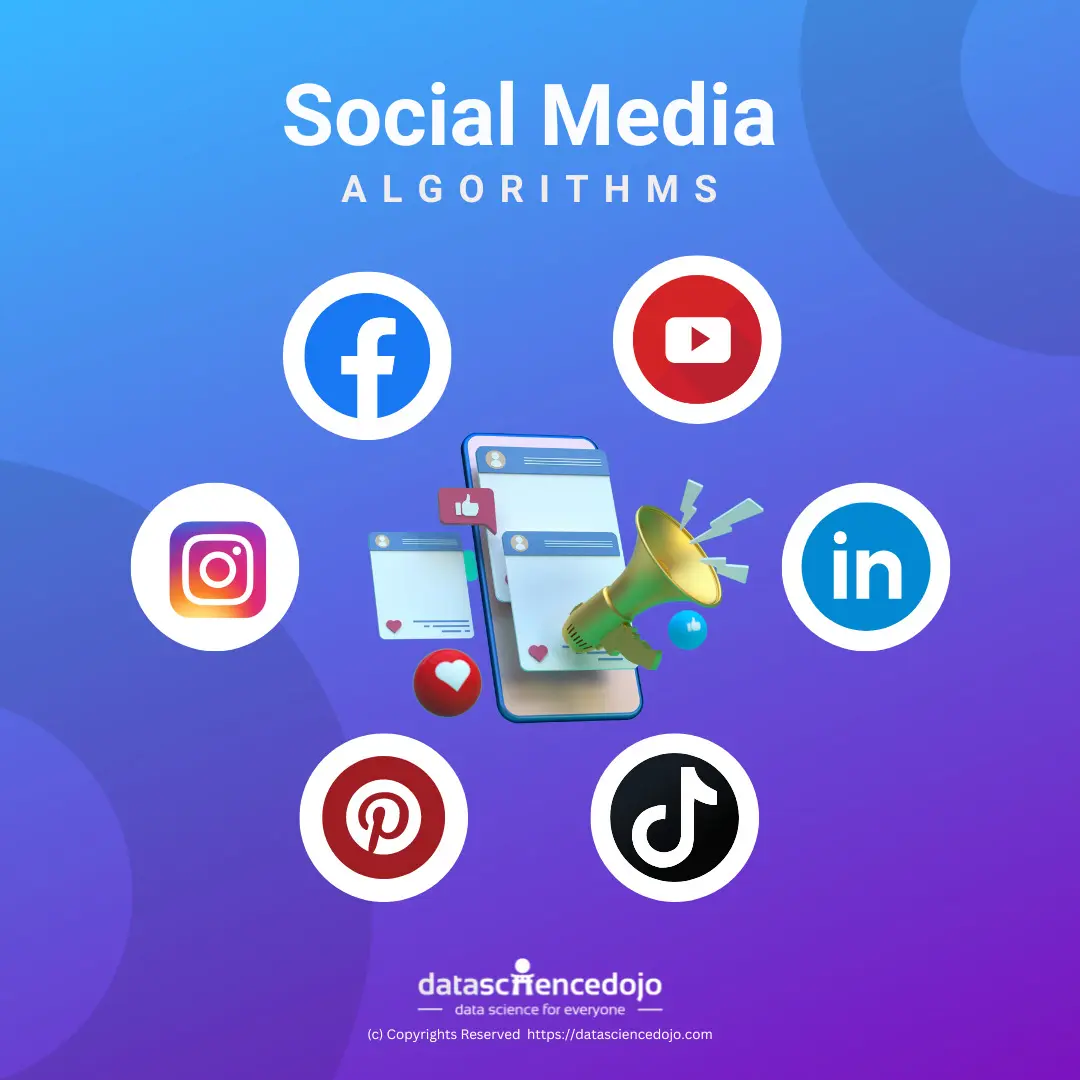In today’s blog, we will try to understand the working behind social media algorithms and focus on the top 6 social media platforms. Algorithms are a part of machine learning which has also become a key area to measure success of digital marketing; these are written by coders to learn human actions. It specifies the behavior of data by using a mathematical set of rules
According to the latest data for 2022, users worldwide spend 147 minutes, on average every day on social media. The use of social media is booming with every passing day. We get hooked up on the content of our interest. But you cannot deny that it is often surprising to experience the content we just discussed with our friends or family.

Social media algorithms sort posts on a user’s feed based on their interest rather than the publishing time. Every content creator desires to get the maximum impressions on their social media postings or their marketing campaigns. That’s where the need to develop quality content comes in. Social media users only experience the content that the algorithms figure out to be most relevant for them.
1. Insights into Facebook algorithm

Facebook had 2.934 billion monthly active users in July 2022.
Anna Stepanov, Head of Facebook App Integrity said “News Feed uses personalized ranking, which considers thousands of unique signals to understand what’s most meaningful to you. Our aim isn’t to keep you scrolling on Facebook for hours on end, but to give you an enjoyable experience that you want to return to.”
On Facebook, which means that the average reach for an organic post is down over 5 percent while the engagement rate is just 0.25 percent which drops to 0.08 percent if you have over 100k followers.
Facebook’s algorithm is not static, it has evolved over the years with the objective to keep its users engaged with the platform. In 2022, Facebook adopted the idea of showing stories to users instead of news, like before. So, what we see on Facebook is no longer a newsfeed but “feed” only.
Further, it works mainly on 3 ranking signals:
- Interactivity:
The more you interact with the posts from one of your friends or family members, Facebook is going to show you their activities relatively more on your feed.
- Interest:
If you like content about cars or automobiles, there’s a high chance Facebook algorithm will push relevant posts to your feed. This happens because we search, like, interact or spend most of our time seeing the content we like.
- Impressions:
Viral or popular content becomes a part of everyone’s Facebook. That’s because the Facebook algorithm promotes content that is in general liked by its users. So, you’re also more likely to see what’s everyone talking about today.
2. How does YouTube algorithm work

There are 2.1 billion monthly active YouTube users worldwide. When you open YouTube, you see multiple streaming options. YouTube says that in 2022, homepages and suggested videos are usually the top sources of traffic for most channels.
The broad selection is narrowed on the user homepage on the basis of two main types of ranking signals.
- Performance:
When a video is uploaded on YouTube, the algorithm evaluates it on the basis of a few key metrics:
- Click-through rate
- Average view duration
- Average percentage viewed
- Likes and dislikes
- Viewer surveys
If a video gains good viewership and engagement by the regular followers of the channel, then the YouTube algorithm will offer that video to more users on YouTube.
- Personalization:
The second-ranking signal for YouTube is personalization. In case you love watching DIY videos, YouTube algorithm processes to keep you hooked on the platform by suggesting interesting DIY videos to you.
Personalization works based on a user’s watch history or the channels you subscribed to lately. It tracks your past behavior and figures out your most preferred streaming options.
Lastly, you must not forget that YouTube acts as a search engine too. So, what you type in the search bar plays a major role in shortlisting the top videos for you.
3. Instagram algorithm explained

In July 2022, Instagram reached 1.440 billion users around the world according to the global advertising audience reach numbers.
The main content on Instagram revolves around posts, stories, and reels. Instagram CEO Adam Mosseri said, “We want to make the most of your time, and we believe that using technology [the Instagram algorithm] to personalize your experience is the best way to do that.”
Let’s shed some light to the Instagram’s top 3 ranking factors for year 2022:
- Interactivity:
Every account holder or influencer on Instagram runs after followers. Because that’s the core to getting your content viewed by the users. To get something on our Instagram feed we need to follow other accounts. As much as our interaction with someone’s content occurs, we will be able to see more of their postings.
- Interest:
This ranking factor has more influence on reels feed and explore page. The more you show interest in watching a specific type of content and tap on it, the more of that category will be shown to you. And it’s not essential to follow someone to see their postings on reels and explore the page.
- Information:
How relevant is the content uploaded on Instagram? This highlights the value of content posted by anyone. If people are talking about it, engaging with it, and sharing it on their stories, you are also going to see it on your feed.
4. Guide to Pinterest algorithm

Being the 15th most active social media platform, Pinterest had 433 million monthly active users in July 2022.
Pinterest is popular amongst audiences who are more likely interested in home décor, aesthetics, food, and style inspirations. This platform carries a slightly different purpose of use than the above-mentioned social media platforms. Therefore, the algorithm works with distinct ranking factors for Pinterest.
Pinterest algorithm promotes pins having:
- High-quality images and visually appealing designs
- Proper use of keywords in the pin descriptions so that pins come up in search results.
- Increased activity on Pinterest and engagement with other users.
Needless to mention, the algorithm weighs more for the pins that are similar to a user’s past pins and search activities.
5. Working process behind LinkedIn algorithm

There are 849.6 million users with LinkedIn in July 2022. LinkedIn is a platform for professionals. People use it to build their social networks and have the right connections that can help them succeed in their careers.
To maintain the authenticity and relevance of connections for professionals, the LinkedIn algorithm processes billions of posts per day to keep the platform valuable for its users. LinkedIn’s ranking factors are mainly these:
- Spam:
LinkedIn considers post as spam if it contains a lot of links, has multiple grammatical errors, and consists of bad vocabulary. Also, avoid using hashtags like #comment, #like, or #follow can flag the system, too.
- Low-quality posts:
There are billions of posts uploaded on LinkedIn every day. The algorithm works to filter out the best for users to engage with. Low-quality posts are not spam but they lack value as compared to other posts. It is evaluated based on the engagement a post receives.
- High-quality content:
You wonder what’s the criteria to create high-quality posts on LinkedIn? Here are some tips to remember:
Easy to read posts
Encourages responses with a question
Uses three or fewer hashtags
Incorporates strong keywords
Tag responsive people to the post
Moreover, LinkedIn appreciates consistency in posts, so it’s recommended to keep your followers engaged not only with informative posts but also conversing with users in the comments section.
6. A sneak peek at the TikTok algorithm

TikTok will have 750 million monthly users worldwide in 2022. In the past couple of years, this social media platform has gained popularity for all the right reasons. The TikTok algorithm is considered as a recommendation system for its users.
We have found one great explanation of TikTok “For You” page algorithm by the platform itself:
“A stream of videos curated to your interests, making it easy to find content and creators you love … powered by a recommendation system that delivers content to each user that is likely to be of interest to that particular user.”
Key ranking factors for the TikTok algorithm are:
- User interactions:
This factor is like the Instagram algorithm, but mainly concerns the following actions of users:
Which accounts do you follow
Comments you’ve posted
Videos you’ve reported as inappropriate
Longer videos you watch all the way to the end (aka video completion rate)
Content you create on your own account
Creators you’ve hidden
Videos you’ve liked or shared on the app
Videos you’ve added to your favorites
Videos you’ve marked as “Not Interested”
Interests you’ve expressed by interacting with organic content and ads
- Video information:
Videos with missing information, incorrect captions, titles, and tags are buried under hundreds of videos being uploaded on TikTok every minute. On the discover tab, your video information signals tend to seek for:
Captions
Sounds
Hashtags*
Effects
Trending topics
- TikTok account settings:
TikTok algorithm optimizes the audience for your video based on the options you selected while creating your account. Some of the device and account settings that decide audience for your videos are:
Language preference
Country setting (you may be more likely to see content from people in your own country)
Type of mobile device
Categories of interest you selected as a new user
Social media algorithms relation with content quality
Apart from all the key ranking factors for each platform, we discussed in this blog, one thing remains ascertain for all i.e., maintain content quality. Every social media platform is algorithm bsed which means it only filters out the best quality content for visitors.
No matter which platform you focus on growing your business or your social network, it highly relies on the meaningful content you provide your connections.
If we missed your favorite social media platform, don’t worry, let us know in the comments and we will share its algorithm in the next blog.


